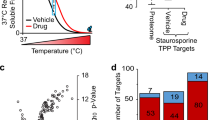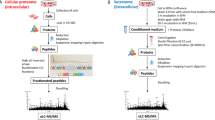Abstract
Activity-based protein profiling (ABPP) has emerged as a valuable chemical proteomics method to guide the therapeutic development of covalent drugs by assessing their on-target engagement and off-target activity. We recently used ABPP to determine the serine hydrolase interaction landscape of the experimental drug BIA 10-2474, thereby providing a potential explanation for the adverse side effects observed with this compound. ABPP allows mapping of protein interaction landscapes of inhibitors in cells, tissues and animal models. Whereas our previous protocol described quantification of proteasome activity using stable-isotope labeling, this protocol describes the procedures for identifying the in vivo selectivity profile of covalent inhibitors with label-free quantitative proteomics. The optimization of our protocol for label-free quantification methods results in high proteome coverage and allows the comparison of multiple biological samples. We demonstrate our protocol by assessing the protein interaction landscape of the diacylglycerol lipase inhibitor DH376 in mouse brain, liver, kidney and testes. The stages of the protocol include tissue lysis, probe incubation, target enrichment, sample preparation, liquid chromatography–mass spectrometry (LC–MS) measurement, data processing and analysis. This approach can be used to study target engagement in a native proteome and to identify potential off targets for the inhibitor under investigation. The entire protocol takes at least 4 d, depending on the number of samples.
This is a preview of subscription content, access via your institution
Access options
Access Nature and 54 other Nature Portfolio journals
Get Nature+, our best-value online-access subscription
$29.99 / 30 days
cancel any time
Subscribe to this journal
Receive 12 print issues and online access
$259.00 per year
only $21.58 per issue
Buy this article
- Purchase on Springer Link
- Instant access to full article PDF
Prices may be subject to local taxes which are calculated during checkout



Similar content being viewed by others
Accession codes
References
Ziegler, S., Pries, V., Hedberg, C. & Waldmann, H. Target identification for small bioactive molecules: finding the needle in the haystack. Angew. Chem. Int. Ed. 52, 2744–2792 (2013).
Bunnage, M.E., Piatnitski Chekler, E.L. & Jones, L.H. Target validation using chemical probes. Nat. Chem. Biol. 9, 195–199 (2013).
Simon, G.M., Niphakis, M.J. & Cravatt, B.F. Determining target engagement in living systems. Nat. Chem. Biol. 9, 200–205 (2013).
Jafari, R. et al. The cellular thermal shift assay for evaluating drug target interactions in cells. Nat. Protoc. 9, 2100–2122 (2014).
Liu, Y., Patricelli, M.P. & Cravatt, B.F. Activity-based protein profiling: the serine hydrolases. Proc. Natl. Acad. Sci. USA 96, 14694–14699 (1999).
Rix, U. & Superti-Furga, G. Target profiling of small molecules by chemical proteomics. Nat. Chem. Biol. 5, 616–624 (2009).
Niphakis, M.J. & Cravatt, B.F. Enzyme inhibitor discovery by activity-based protein profiling. Annu. Rev. Biochem. 83, 341–377 (2014).
Cravatt, B.F., Wright, A.T. & Kozarich, J.W. Activity-based protein profiling: from enzyme chemistry to proteomic chemistry. Annu. Rev. Biochem. 77, 383–414 (2008).
Willems, L.I., Overkleeft, H.S. & Van Kasteren, S.I. Current developments in activity-based protein profiling. Bioconjug. Chem. 25, 1181–1191 (2014).
Marques, A.R. et al. A specific activity-based probe to monitor family GH59 galactosylceramidase - the enzyme deficient in Krabbe disease. ChemBioChem 18, 402–412 (2017).
Zhao, Q. et al. Broad-spectrum kinase profiling in live cells with lysine-targeted sulfonyl fluoride probes. J. Am. Chem. Soc. 139, 680–685 (2017).
Li, N. et al. Relative quantification of proteasome activity by activity-based protein profiling and LC-MS/MS. Nat. Protoc. 8, 1155–68 (2013).
Speers, A.E. & Cravatt, B.F. Activity-based protein profiling (ABPP) and click chemistry (CC)-ABPP by MudPIT mass spectrometry. Curr. Protoc. Chem. Biol. 1, 29–41 (2009).
Sieber, S.A. & Cravatt, B.F. Analytical platforms for activity-based protein profiling - exploiting the versatility of chemistry for functional proteomics. Chem. Commun. 22, 2311–2319 (2006).
Bantscheff, M., Lemeer, S., Savitski, M.M. & Kuster, B. Quantitative mass spectrometry in proteomics: critical review update from 2007 to the present. Anal. Bioanal. Chem. 404, 939–965 (2012).
Rauniyar, N. & Yates, J.R. Isobaric labeling-based relative quantification in shotgun proteomics. J. Proteome Res. 13, 5293–5309 (2014).
Neilson, K.A. et al. Less label, more free: approaches in label-free quantitative mass spectrometry. Proteomics 11, 535–553 (2011).
Filiou, M.D., Martins-de-Souza, D., Guest, P.C., Bahn, S. & Turck, C.W. To label or not to label: applications of quantitative proteomics in neuroscience research. Proteomics 12, 736–747 (2012).
Distler, U., Kuharev, J., Navarro, P. & Tenzer, S. Label-free quantification in ion mobility-enhanced data-independent acquisition proteomics. Nat. Protoc. 11, 795–812 (2016).
Kleiner, P., Heydenreuter, W., Stahl, M., Korotkov, V.S. & Sieber, S.A. A whole proteome inventory of background photocrosslinker binding. Angew. Chem. Int. Ed. 56, 1396–1401 (2017).
Yang, W.S. et al. Regulation of ferroptotic cancer cell death by GPX4. Cell 156, 317–331 (2014).
Doerr, A. DIA mass spectrometry. Nat. Methods 12, 35 (2015).
Baker, E.S. et al. An LC-IMS-MS platform providing increased dynamic range for high-throughput proteomic studies. J. Proteome Res. 9, 997–1006 (2010).
Bond, N.J., Shliaha, P.V., Lilley, K.S. & Gatto, L. Improving qualitative and quantitative performance for MSE-based label-free proteomics. J. Proteome Res. 12, 2340–2353 (2013).
van Esbroeck, A.C.M. et al. Activity-based protein profiling reveals off-target proteins of the FAAH inhibitor BIA 10-2474. Science 356, 1084–1087 (2017).
Baggelaar, M.P. et al. Development of an activity-based probe and in silico design reveal highly selective inhibitors for diacylglycerol lipase-α in brain. Angew. Chem. Int. Ed. 52, 12081–12085 (2013).
Baggelaar, M.P. et al. A highly selective, reversible inhibitor identified by comparative chemoproteomics modulates diacylglycerol lipase activity in neurons. J. Am. Chem. Soc. 137, 8851–8857 (2015).
Bisogno, T. et al. Cloning of the first sn1-DAG lipases points to the spatial and temporal regulation of endocannabinoid signaling in the brain. J. Cell Biol. 163, 463–468 (2003).
Baggelaar, M.P. et al. Chemical proteomics maps brain region specific activity of endocannabinoid hydrolases. ACS Chem. Biol. 12, 852–861 (2017).
Ogasawara, D. et al. Rapid and profound rewiring of brain lipid signaling networks by acute diacylglycerol lipase inhibition. Proc. Natl. Acad. Sci. USA 113, 26–33 (2016).
Deng, H. et al. Triazole ureas act as diacylglycerol lipase inhibitors and prevent fasting-induced refeeding. J. Med. Chem. 60, 428–440 (2017).
Lomenick, B. et al. Target identification using drug affinity responsive target stability (DARTS). Proc. Natl. Acad. Sci. USA 106, 21984–21989 (2009).
Distler, U. et al. Drift time-specific collision energies enable deep-coverage data-independent acquisition proteomics. Nat. Methods 11, 167–70 (2014).
Ogura, Y., Parsons, W.H., Kamat, S.S. & Cravatt, B.F. A calcium-dependent acyltransferase that produces N-acyl phosphatidylethanolamines. Nat. Chem. Biol. 12, 1–5 (2016).
Wessel, D. & Flügge, U.I. A method for the quantitative recovery of protein in dilute solution in the presence of detergents and lipids. Anal. Biochem. 138, 141–143 (1984).
Silva, J.C., Gorenstein, M.V., Li, G.-Z., Vissers, J.P.C. & Geromanos, S.J. Absolute quantification of proteins by LCMSE: a virtue of parallel MS acquisition. Mol. Cell. Proteomics 5, 144–156 (2005).
Choi, M. et al. ABRF Proteome Informatics Research Group (iPRG) 2015 study: detection of differentially abundant proteins in label-free quantitative LC-MS/MS experiments. J. Proteome Res. 16, 945–957 (2017).
Vizcaíno, J.A. et al. 2016 Update of the PRIDE database and its related tools. Nucleic Acids Res. 44, D447–D456 (2016).
Rappsilber, J., Mann, M. & Ishihama, Y. Protocol for micro-purification, enrichment, pre-fractionation and storage of peptides for proteomics using StageTips. Nat. Protoc. 2, 1896–1906 (2007).
Vaudel, M. et al. Shedding light on black boxes in protein identification. Proteomics 14, 1001–1005 (2014).
Wasmuth, E.V. & Lima, C.D. UniProt: the universal protein knowledgebase. Nucleic Acids Res. 45, 1–12 (2016).
Acknowledgements
We thank U. Distler and S. Tenzer for their advice and helpful discussions. We acknowledge ChemAxon for kindly providing the Instant JChem software to manage our compound library. This work was supported by grants from the Chinese Scholarship Council (to H.D. and J.Z.) and a Dutch Research Council–Chemical Sciences ECHO grant (to M.v.d.S.).
Author information
Authors and Affiliations
Contributions
E.J.v.R. designed and performed experiments, analyzed data and wrote the paper; B.I.F., H.D. and J.Z. treated the mice; B.I.F. performed experiments and wrote the paper; M.P.B. and A.C.M.v.E. developed the initial protocol, and H.S.O and M.v.d.S. wrote the paper.
Corresponding author
Ethics declarations
Competing interests
The authors declare no competing financial interests.
Integrated supplementary information
Supplementary Figure 1 Successful methanol/chloroform precipitation.
Photos of a successfully performed methanol/chloroform precipitation (Steps 14-21).
Supplementary Figure 2 Relative activity of the target enzymes in each tissue treated with DH376 compared to vehicle control.
Error bars are ratio of error (calculated as described in step 66 of the protocol).
Supplementary Figure 3 Putative probe targets identified in mouse brain membrane proteome.
Venn diagram of putative probe targets identified in mouse brain membrane proteome with THL-biotin (blue), FP-biotin (red) or a mix of both (cocktail; purple).
Supplementary Figure 4 Relative activity of the target enzymes in each tissue treated with DH376 compared to vehicle control.
Mean + standard deviation is shown.
Supplementary information
Supplementary Text and Figures
Supplementary Figures 1–4 (PDF 877 kb)
Supplementary Data 1
Protein sequence database. (ZIP 6017 kb)
Supplementary Data 2
Quantified proteins. (ZIP 1381 kb)
Supplementary Data 3
Quantified peptides. (ZIP 195 kb)
Supplementary Data 4
Putative probe targets. (ZIP 2 kb)
Rights and permissions
About this article
Cite this article
van Rooden, E., Florea, B., Deng, H. et al. Mapping in vivo target interaction profiles of covalent inhibitors using chemical proteomics with label-free quantification. Nat Protoc 13, 752–767 (2018). https://doi.org/10.1038/nprot.2017.159
Published:
Issue Date:
DOI: https://doi.org/10.1038/nprot.2017.159
This article is cited by
-
Skeletal muscle-secreted DLPC orchestrates systemic energy homeostasis by enhancing adipose browning
Nature Communications (2023)
-
A monoacylglycerol lipase inhibitor showing therapeutic efficacy in mice without central side effects or dependence
Nature Communications (2023)
-
Advanced technologies for single-cell in situ protein profiling
Science China Chemistry (2022)
-
Effects of microgravity exposure and fructo-oligosaccharide ingestion on the proteome of soleus and extensor digitorum longus muscles in developing mice
npj Microgravity (2021)
-
Target identification of natural medicine with chemical proteomics approach: probe synthesis, target fishing and protein identification
Signal Transduction and Targeted Therapy (2020)
Comments
By submitting a comment you agree to abide by our Terms and Community Guidelines. If you find something abusive or that does not comply with our terms or guidelines please flag it as inappropriate.



